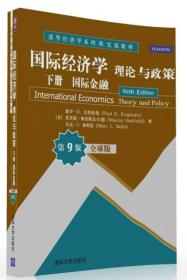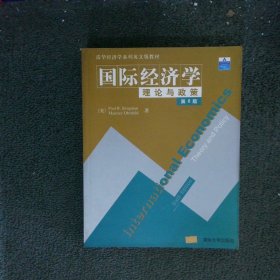
国际经济学:理论与政策 下册 国际金融 全球版·第9版
¥ 32.69 6.7折 ¥ 49 全新
仅1件
山东泰安
认证卖家担保交易快速发货售后保障
作者[美]保罗·R.克鲁格曼(Paul R.Krugman) 著
出版社清华大学出版社
出版时间2016-07
版次9
装帧平装
货号R2库 12-2
上书时间2024-12-03
- 在售商品 暂无
- 平均发货时间 25小时
- 好评率 暂无
- 最新上架
商品详情
- 品相描述:全新
图书标准信息
- 作者 [美]保罗·R.克鲁格曼(Paul R.Krugman) 著
- 出版社 清华大学出版社
- 出版时间 2016-07
- 版次 9
- ISBN 9787302442325
- 定价 49.00元
- 装帧 平装
- 开本 16开
- 纸张 胶版纸
- 页数 400页
- 丛书 清华经济学系列英文版教材
- 【内容简介】
-
本书配有大量的案例、专栏和图表,注重理论在实践中的应用。作者以其多年来对国际经济学的研究和实践经验,系统介绍了国际贸易理论和政策、国际收支平衡、汇率决定和国际宏观经济政策的新研究成果,是一本不可多得的国际经济学教材。本书分上下两册,上册是国际贸易部分(第2~12章),下册是国际金融部分(第13~22章),两部分自成体系,因此,授课老师可以根据课时需要自行安排授课。
- 【作者简介】
-
保罗·R. 克鲁格曼,普林斯顿大学教授,2008年诺贝尔经济学奖获得者,目前还担任许多国家和地区的经济政策咨询顾问。他的主要研究领域包括国际贸易、国际金融、货币危机与汇率变化理论,被誉为当今世界上令人瞩目的贸易理论家之一。
- 【目录】
-
Part 3 Exchange Rates and Open-Economy Macroeconomics 323
13 National Income Accounting and the Balance of Payments 323
14 Exchange Rates and the Foreign Exchange Market:
350
384
414
451
An Asset Approach
15 Money, Interest Rates, and Exchange Rates
16 Price Levels and the Exchange Rate in the Long Run
17 Output and the Exchange Rate in the Short Run
18 Fixed Exchange Rates and Foreign Exchange Intervention 493
Part 4 International Macroeconomic Policy 534
534
587
616
19 International Monetary Systems: An Historical Overview
20 Optimum Currency Areas and the European Experience
21 Financial Globalization: Opportunity and Crisis
22 Developing Countries: Growth, Crisis, and Reform 649
Mathematical Postscripts
Postscript to Chapter 21: Risk Aversion and International Portfolio Diversification 691
Credits 698
Index 699
viii
ix
Contents
Preface xvi
Part 3 Exchange Rates and Open-Economy Macroeconomics 323
13 National Income Accounting and the Balance of Payments 323
The National Income Accounts325
National Product and National Income326
Capital Depreciation and International Transfers327
Gross Domestic Product327
National Income Accounting for an Open Economy328
Consumption328
Investment328
Government Purchases329
The National Income Identity for an Open Economy329
An Imaginary Open Economy329
The Current Account and Foreign Indebtedness330
Saving and the Current Account332
Private and Government Saving333
CASE STUDY: Government Deficit Reduction May Not Increase
the Current Account Surplus334
The Balance of Payments Accounts336
Examples of Paired Transactions337
The Fundamental Balance of Payments Identity338
The Current Account, Once Again339
The Capital Account340
The Financial Account340
Net Errors and Omissions341
Official Reserve Transactions342
CASE STUDY: The Assets and Liabilities of the World’s Biggest Debtor343
Summary346
14 Exchange Rates and the Foreign Exchange Market: An Asset Approach 350
Exchange Rates and International Transactions351
Domestic and Foreign Prices351
Exchange Rates and Relative Prices353
The Foreign Exchange Market354
The Actors354
Characteristics of the Market355
Spot Rates and Forward Rates356
Foreign Exchange Swaps358
Futures and Options358
The Demand for Foreign Currency Assets358
Assets and Asset Returns359
BOX: Nondeliverable Forward Exchange Trading in Asia360
Risk and Liquidity362
Interest Rates362
Exchange Rates and Asset Returns364
A Simple Rule364
Return, Risk, and Liquidity in the Foreign Exchange Market366
Equilibrium in the Foreign Exchange Market367
Interest Parity: The Basic Equilibrium Condition367
How Changes in the Current Exchange Rate Affect Expected Returns368
The Equilibrium Exchange Rate369
Interest Rates, Expectations, and Equilibrium371
The Effect of Changing Interest Rates on the Current Exchange Rate372
The Effect of Changing Expectations on the Current Exchange Rate373
x Contents
CASE STUDY: What Explains the Carry Trade?374
Summary376
Appendix: Forward Exchange Rates and Covered
Interest Parity381
384
Money Defined: A Brief Review385
Money as a Medium of Exchange385
Money as a Unit of Account385
Money as a Store of Value386
What Is Money?386
How the Money Supply Is Determined386
The Demand for Money by Individuals387
Expected Return387
Risk388
Liquidity388
Aggregate Money Demand388
The Equilibrium Interest Rate: The Interaction of Money
Supply and Demand390
Equilibrium in the Money Market390
Interest Rates and the Money Supply392
Output and the Interest Rate393
The Money Supply and the Exchange Rate in the Short Run393
Linking Money, the Interest Rate, and the Exchange Rate394
U.S. Money Supply and the Dollar/Euro Exchange Rate395
Europe’s Money Supply and the Dollar/Euro Exchange Rate396
Money, the Price Level, and the Exchange Rate in the Long Run398
Money and Money Prices399
The Long-Run Effects of Money Supply Changes399
Empirical Evidence on Money Supplies and Price Levels400
Money and the Exchange Rate in the Long Run401
Inflation and Exchange Rate Dynamics402
Short-Run Price Rigidity versus Long-Run Price Flexibility402
BOX: Money Supply Growth and Hyperinflation in Bolivia404
Permanent Money Supply Changes and the Exchange Rate404
Exchange Rate Overshooting407
CASE STUDY: Can Higher Inflation Lead to Currency Appreciation?
The Implications of Inflation Targeting408
Summary411
414
The Law of One Price415
Purchasing Power Parity416
The Relationship Between PPP and the Law of One Price416
Absolute PPP and Relative PPP417
A Long-Run Exchange Rate Model Based on PPP418
The Fundamental Equation of the Monetary Approach418
15 Money, Interest Rates, and Exchange Rates
16 Price Levels and the Exchange Rate in the Long Run
Ongoing Inflation, Interest Parity, and PPP420
The Fisher Effect421
Empirical Evidence on PPP and the Law of One Price424
Explaining the Problems with PPP425
Trade Barriers and Nontradables426
Departures from Free Competition427
Differences in Consumption Patterns and Price Level Measurement427
Contents xi
BOX: Some Meaty Evidence on the Law of One Price428
PPP in the Short Run and in the Long Run430
CASE STUDY: Why Price Levels Are Lower in Poorer Countries431
Beyond Purchasing Power Parity: A General Model of Long-Run
Exchange Rates433
The Real Exchange Rate434
Demand, Supply, and the Long-Run Real Exchange Rate435
BOX: Sticky Prices and the Law of One Price: Evidence
from Scandinavian Duty-Free Shops436
Nominal and Real Exchange Rates in Long-Run Equilibrium438
International Interest Rate Differences and the Real Exchange Rate440
Real Interest Parity442
Summary443
Appendix: The Fisher Effect, the Interest Rate, and the Exchange Rate
Under the Flexible-Price Monetary Approach448
17 Output and the Exchange Rate in the Short Run 451
Determinants of Aggregate Demand in an Open Economy452
Determinants of Consumption Demand452
Determinants of the Current Account453
How Real Exchange Rate Changes Affect the Current Account454
How Disposable Income Changes Affect the Current Account454
The Equation of Aggregate Demand455
The Real Exchange Rate and Aggregate Demand455
Real Income and Aggregate Demand455
How Output Is Determined in the Short Run456
Output Market Equilibrium in the Short Run: The DD Schedule458
Output, the Exchange Rate, and Output Market Equilibrium458
Deriving the DD Schedule459
Factors That Shift the DD Schedule459
Asset Market Equilibrium in the Short Run: The AA Schedule462
Output, the Exchange Rate, and Asset Market Equilibrium462
Deriving the AA Schedule464
Factors That Shift the AA Schedule464
Short-Run Equilibrium for an Open Economy: Putting the DD and AA
Schedules Together465
Temporary Changes in Monetary and Fiscal Policy467
Monetary Policy468
Fiscal Policy468
Policies to Maintain Full Employment469
Inflation Bias and Other Problems of Policy Formulation471
Permanent Shifts in Monetary and Fiscal Policy472
A Permanent Increase in the Money Supply472
Adjustment to a Permanent Increase in the Money Supply472
A Permanent Fiscal Expansion474
xii Contents
Macroeconomic Policies and the Current Account476
Gradual Trade Flow Adjustment and Current Account Dynamics477
The J-Curve477
Exchange Rate Pass-Through and Inflation479
BOX: Exchange Rates and the Current Account480
The Liquidity Trap481
Summary484
Appendix 1: Intertemporal Trade and Consumption Demand488
Appendix 2: The Marshall-Lerner Condition and Empirical
Estimates of Trade Elasticities490
18 Fixed Exchange Rates and Foreign Exchange Intervention 493
Why Study Fixed Exchange Rates?494
Central Bank Intervention and the Money Supply495
The Central Bank Balance Sheet and the Money Supply495
Foreign Exchange Intervention and the Money Supply497
Sterilization497
The Balance of Payments and the Money Supply498
How the Central Bank Fixes the Exchange Rate499
Foreign Exchange Market Equilibrium Under a Fixed Exchange Rate499
Money Market Equilibrium Under a Fixed Exchange Rate500
A Diagrammatic Analysis501
Stabilization Policies with a Fixed Exchange Rate502
Monetary Policy502
Fiscal Policy503
Changes in the Exchange Rate504
Adjustment to Fiscal Policy and Exchange Rate Changes506
Balance of Payments Crises and Capital Flight506
Managed Floating and Sterilized Intervention509
Perfect Asset Substitutability and the Ineffectiveness of Sterilized Intervention509
BOX: Brazil’s 1998–1999 Balance of Payments Crisis510
点击展开
点击收起
相关推荐
— 没有更多了 —




















以下为对购买帮助不大的评价